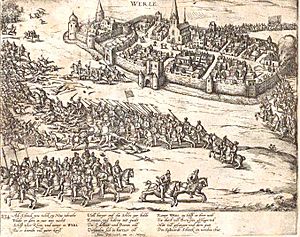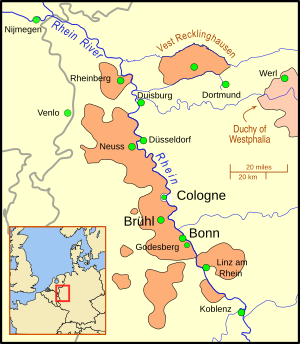Battle of Werl facts for kids
Quick facts for kids Battle of Werl |
|||||||||
|---|---|---|---|---|---|---|---|---|---|
| Part of Cologne War | |||||||||
 |
|||||||||
|
|||||||||
| Belligerents | |||||||||
| Commanders and leaders | |||||||||
| Martin Schenck von Nydeggen Hermann Friedrich Cloedt |
Claude de Berlaymont, known as Haultpenne | ||||||||
| Strength | |||||||||
| 500 foot; 500 horse | 4000 horse, foot and guns | ||||||||
| Casualties and losses | |||||||||
| approximately 250 | approximately 500 | ||||||||
The Battle of Werl took place from March 3 to 8, 1586. It was part of a month-long military action in the Duchy of Westphalia. This action involved soldiers fighting for Gebhard Truchsess von Waldburg. He was the Protestant (Calvinist) Archbishop-Prince Elector of Cologne.
Before the battle, Gebhard's soldiers, led by Hermann Friedrich Cloedt and Martin Schenck, took many goods from the towns of Vest and Recklinghausen. This made the local farmers and merchants in Westphalia unhappy with Gebhard's cause. Schenck used a clever trick to capture the fortress at Werl. However, he could not fully defeat the guards inside. A much larger army, led by Claude de Berlaymont, then surrounded Schenck's forces in the city. Schenck managed to escape, taking some local officials as hostages and carrying away the goods his men had taken. They then crossed the Rhine river to safety.
Contents
Why the Battle Happened
The Battle of Werl was a small part of a bigger conflict called the Cologne War. This war started because of a disagreement over who should lead the important region of Cologne. In 1583, Gebhard, the Archbishop-Prince Elector, changed his religion to Calvinism. He also married Agnes von Mansfeld-Eisleben. This was a big problem because archbishops were not supposed to marry. Also, Gebhard said that both Protestants and Catholics should have equal rights in Cologne.
Because of this, the church leaders in Cologne chose a new archbishop, Ernst of Bavaria. But Gebhard refused to give up his position. He used his army to hold onto it. Ernst then asked his brother, Ferdinand, for military help. At first, the fight was only between Gebhard's forces and Ernst's forces. By 1585, neither side was winning. So, Gebhard asked for help from the Dutch, and Ernst asked for help from Alexander Farnese, Duke of Parma.
Schenck's Campaign in Westphalia
In March 1586, Martin Schenck von Nydeggen led 500 foot soldiers and 500 horsemen into Westphalia. He was joined by Hermann Friedrich Cloedt, who was the commander of the fortified town of Neuss. Their main goal was to capture and secure two important strongholds for Gebhard. These were the towns of Recklinghausen and Werl. They wanted to protect these places from attacks by Ernst's army or the Duke of Parma's forces.
Schenck's troops crossed the Rhine river. They then took goods from several towns in Westphalia. These towns included Hamm, Soest, Unna, Vest, and Waltrop. They also took things from farms and villages in between these towns. During their campaign, they also damaged several churches. They removed valuable items like religious statues and tapestries. In Soest, they caused trouble for the local church leader.
Trapped in Werl
After taking goods from Vest Recklinghausen, Schenck captured Werl on March 1. He used a clever trick to get inside. He loaded wagons with his soldiers and covered them with salt. Salt was a very valuable product at the time. When the guards saw the wagons of salt outside the city, they quickly opened the gates. Once inside, the "salted soldiers" quickly overpowered the guards and took control of the town.
However, some of the city's defenders managed to escape into the Werl citadel, which was a strong fortress. Schenck and his troops tried to storm the citadel many times, but they could not capture it. Since they couldn't take the citadel, they took many things from the city itself.
Count Claude von Berlaymont, also known as Haultpenne, arrived with a large army of 4,000 soldiers. He surrounded Schenck's forces in Werl. Haultpenne had heavy cannons and many horsemen. Even though he had many more soldiers than Schenck's 500, he did not want to fire his cannons at the town. Schenck and Cloedt were surrounded outside by Haultpenne's army. They were also attacked from inside by the hundreds of guards in the Werl citadel.
Schenck's men tried to break out once, but they were forced back into the city. About 50 of their soldiers were left outside the gates when they closed. These soldiers escaped into the nearby forest. They then attacked some farms while waiting for their commanders to try another breakout.
Inside the fortress, Cloedt and Schenck loaded their wagons with all the goods they had taken. They also took 30 local officials as hostages. Then, they attacked Haultpenne's army. They killed about 500 of Haultpenne's soldiers, while losing about 200 of their own. After fighting their way through Haultpenne's forces, they reached Kettwick. They then crossed the Rhine river, above Dortmund. Cloedt went back to his command at Neuss. This town was later surrounded and destroyed by Alexander Farnese, Duke of Parma. Schenck went to Venlo on the Neuss river.
What Happened Next
For Schenck, the battle and the campaign in Westphalia were a success. He came to Westphalia as a soldier looking for money, and he left with a lot of it. After crossing the Rhine, he left his money and his wife in Venlo. He then went to Delft to report to Philip William, Prince of Orange. While there, Robert Dudley, Earl of Leicester, who was the English Governor-General of the Dutch, made him a knight. This was ordered by Elizabeth I, the Queen of England. Schenck also received a valuable gold chain.
For Gebhard, the Battle of Werl in 1586 and the campaign in Westphalia did not help him. In fact, they caused him some serious problems. Schenck failed to capture any strong fortresses for the long term. This left Gebhard's lands and forces isolated. They could not get help from other Protestant leaders in the east. Any help would have to fight through the Spanish army. The goods Schenck took were mostly from farmers and merchants. While these helped Schenck and his soldiers, they did little for Gebhard's money problems, which were very bad by then. Also, Schenck's actions made the people of Westphalia dislike Gebhard's cause.
In the bigger picture of the Cologne War, the failure of the Westphalia campaign and Schenck's retreat from Werl marked the beginning of the end for Gebhard Truchsess von Waldburg. He soon lost his position as archbishop and prince-elector of Cologne. Once the Spanish army joined the fight, the Catholic side became much stronger. The loss of Cologne to the Catholic leader, Ernst of Bavaria, meant that the Wittelsbach family gained more power in northwestern Germany. It also led to the Jesuit-run establishment of a strong Catholic center on the lower Rhine. This also gave Spain important bases on the Rhine river, which they could use to attack the Protestant Dutch provinces.
Images for kids
See also
 In Spanish: Batalla de Werl para niños
In Spanish: Batalla de Werl para niños



